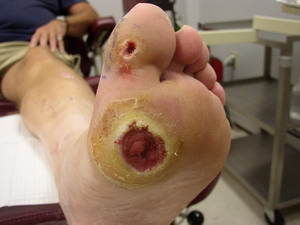| FOOT
DISORDERS - Diabetic Foot |
Diabetes is a disease which causes changes in
many organ systems. Those with diabetes, especially those with poor control of
their disease, have a high risk of eye disease, kidney disease and amputation.
It is estimated that 15% of diabetics will undergo an amputation of the foot or
leg. Two million Canadians have diabetes. Seven hundred thousand people in
Canada donít know that they have diabetes.
Foot ulceration, infection and amputation are the result of the effects of
diabetes on the vascular system, the nervous system and the immune system.
Nerves can be injured by high blood sugar resulting in pain, burning sensations
and eventually numbness. The nerves that relay pain and temperature are injured
first. The damage starts in areas furthest from the brain and spinal cord: the
feet. This is called peripheral neuropathy. It inhibits the ability to feel pain
from injuries to the feet. Simple injuries such as blisters or small cuts can
lead to limb threatening infections. Diabetes can also decrease blood flow to
the feet. This inhibits the bodyís ability to heal small wounds and can also
limit the amount of antibiotics available to fight bacteria in an area of
infection. It also causes skin changes including dryness and tightness. The
ability of the immune system to fight infection is also affected by diabetes.
Signs of diabetes include, but are not limited to, constant thirst, hunger,
frequent urination, visual changes and sometimes burning or numbness in the
feet. \

- Control your diabetes. Your risk is
decreased by good control of the disease.
- Wash your feet daily. Dry carefully between
the toes.
- Apply a moisturizer to feet lightly after
bathing. It is important for you to keep your skin soft and supple.
- Do not cut toenails too short. The corners
of the nails should always be visible. If you have difficulty reaching or
seeing your feet have someone else cut your toenails.
- Stop smoking. Smoking reduces blood
circulation and increases your risk of amputation.
- Wear comfortable, well-fitting shoes.
- Examine feet every day for cuts, blisters,
dry blood, redness or swelling. Call your podiatrist immediately if you
notice a problem. Hours can make the difference between saving your foot and
losing it.
- Inspect the inside of shoes for foreign
objects.
- Never use hot water bottles or heating pads.
These can cause serious burns.
- Donít walk barefoot, even indoors.
- Donít trim corns or calluses with any type
of blade. An emery board can be used safely if necessary.
- Donít use corn removal pads, liquids or wart
treatments. These products contain acids that can cause and ulcer or hole in
the skin.
- Donít wear open-toed shoes, particularly
sandals with thongs between toes.
- Educate you regarding diabetes and foot
complications.
- Care for areas that are at risk for
ulceration.
- Consult nerve and vascular specialists where
appropriate.
- Make protective insoles to decrease pressure
on problem areas.
- Perform surgery to reduce the risk of ulcer
and infection.
- Perform wound care for ulcers.
- Diabetic ulcers Ė the loss of skin and
subcutaneous tissue over areas of pressure
- Neuropathy Ė loss of sensation due to damage
to peripheral nerves
- Charcot joint disease Ė Severe destructive
joint changes to the neuropathic foot
- Diabetic osteolysis Ė the resorbtion of
bone, especially of the forefoot bones
- Osteomyelitis Ė infection of bone, usually
from an overlying skin ulcer
- Amputation of foot or leg due to severe
infection


